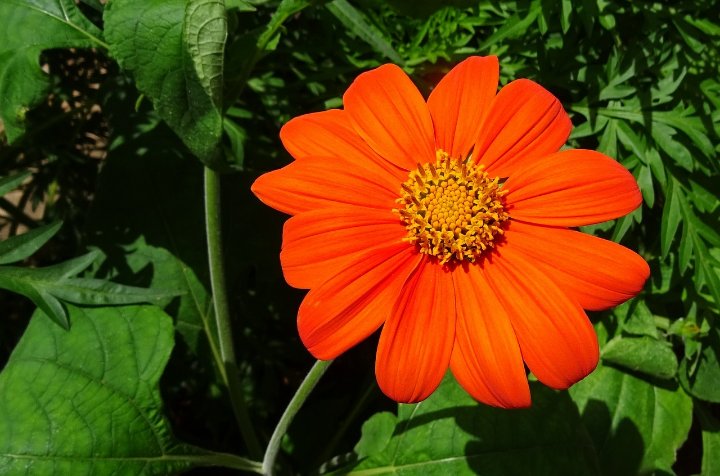Tithonia, commonly known as Mexican Sunflower, is a dazzling addition to any garden, boasting vibrant blooms that attract pollinators and add a burst of color to the landscape. Let’s delve into the details of cultivating this stunning annual and ensuring its optimal growth and bloom.
Best Tithonia Varieties
| Image | Name | Rating | Shop |
|---|---|---|---|
 | Tithonia Mexican Sunflower Flower Seed Mix |  | |
 | Mexican Sunflower ‘Torch’ Tithonia Rotundifolia Flower |  | |
 | Mexican Sunflower Seed |  | |
 | Mexican Sunflower Seeds – Extra Large Packet |  |
Tithonia Hardiness Zones
Before you embark on growing Tithonia, it’s essential to determine whether your region falls within its suitable hardiness zones. Tithonia thrives in USDA hardiness zones 9 to 11, where it can enjoy the warm temperatures and long growing seasons that it favors. In areas outside of these zones, Tithonia is typically grown as an annual.
How Much Sun Do Tithonia Need
Tithonia is a sun-loving plant that thrives in full sunlight. To ensure robust growth and prolific blooming, provide your Tithonia plants with at least six to eight hours of direct sunlight each day. Planting them in a location with ample sunlight exposure will promote sturdy stems, lush foliage, and an abundance of vibrant flowers.
Tithonia Soil Requirements
Preparing the right soil environment is crucial for the success of your Tithonia plants. Aim for well-drained soil with a loamy texture that allows excess moisture to drain away freely. While Tithonia can tolerate various soil types, it performs best in moderately fertile soil that is rich in organic matter. Before planting, amend heavy clay soils with compost or organic matter to improve drainage and soil structure.
Tithonia Soil pH
Maintaining a neutral to slightly acidic soil pH is ideal for Tithonia cultivation. Aim for a pH range between 6.0 and 7.0 to ensure optimal nutrient availability and root health. Conduct a soil test before planting to determine the pH of your soil and make any necessary adjustments using organic soil amendments or pH-adjusting products.
Tithonia Plant Spacing
When planting Tithonia, provide ample space for its robust growth habit. Space the plants approximately 3 to 6 feet apart to allow them room to spread and develop. Proper spacing not only encourages better air circulation around the plants but also minimizes competition for nutrients and water, promoting healthier growth and fewer pest and disease issues.
Tithonia Water Requirements
While Tithonia is known for its drought tolerance once established, adequate moisture is crucial, especially during the establishment period. Water your Tithonia plants deeply and infrequently, allowing the soil to dry out slightly between waterings. Avoid overwatering, as it can lead to root rot and other moisture-related issues. Once established, Tithonia typically thrives with minimal supplemental watering, making it an excellent choice for water-wise gardens.
Tithonia Temperature Requirements
Tithonia thrives in warm temperatures and loves the heat. Plant your Tithonia in a location where it will receive plenty of sunlight and warmth throughout the growing season. Avoid planting too early in the spring when temperatures are still cool, as Tithonia prefers consistently warm conditions to reach its full potential.
Tithonia Humidity Requirements
While Tithonia can tolerate a wide range of humidity levels, it generally prefers average humidity levels. In regions with high humidity, ensure proper air circulation around the plants to minimize the risk of fungal diseases. Water the plants at the base to avoid wetting the foliage, as damp conditions can promote fungal growth.
Tithonia Fertilizer Requirements
Tithonia is a relatively low-maintenance plant that can thrive without the need for additional fertilization, provided the soil is moderately fertile. However, if your soil is nutrient-depleted or if you want to encourage more vigorous growth and blooming, you can apply a balanced, slow-release fertilizer at the beginning of the growing season. Avoid over-fertilizing, as excessive nitrogen can lead to lush foliage at the expense of flowers.
Tithonia Pests
Keep an eye out for common pests that may affect your Tithonia plants, including snails and slugs. These pests may feed on the foliage and flowers, causing unsightly damage. To manage pest populations, handpick snails and slugs and use organic pest control methods such as diatomaceous earth or copper barriers.
Tithonia Diseases
While Tithonia is relatively resistant to diseases, it may occasionally encounter issues such as powdery mildew, especially in humid conditions. To prevent fungal diseases, ensure proper air circulation around the plants by spacing them adequately and avoid overhead watering, which can promote moisture on the foliage. If fungal diseases occur, treat affected plants with fungicidal sprays according to label instructions.
By following these guidelines and providing attentive care, you can cultivate healthy and vibrant Tithonia plants that enhance the beauty of your garden with their striking blooms. With the right conditions and a little nurturing, your Tithonia garden will be a sight to behold, attracting pollinators and delighting onlookers with its radiant flowers throughout the growing season.















